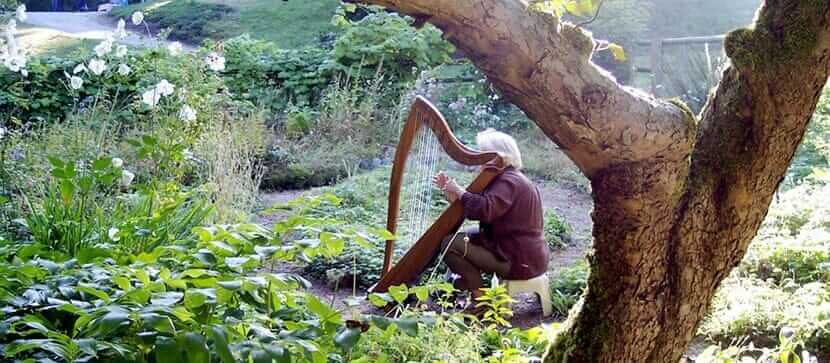Volunteer Mara Grey and I met in the Appletree Garden on a dewy morning last month to discuss the garden—which she’s stewarded for about a decade—and the diversity of plants she tends there. She introduced me to my favorite summer bloomer—Crocosmia Lucifer—and told me how the garden has evolved since last we spoke. Here’s that conversation. —Marnie Jackson
Last time we spoke, you shared about the growing diversity of plants in this garden. Would you say that’s still part of your work here?
Yes, this garden holds a diversity of plants connected to many areas of the world. New Zealand, South Africa, Northern Europe. There’s one plant that’s one of the first that comes in after a glacier recedes. A lot of these plants have very interesting backgrounds. We have these little tulips, for instance, from Central Asia—Afghanistan. Not a place you’d associate with tulips, ordinarily!
Do you have plants here that were hard to come by?
Oh, yes. I like very rare plants. I started off as a botanist, and I’ve met people who are into really difficult-to-grow things. I like a great variety of plants, and I think diversity helps the garden.
When I was studying botany at the University, I remember getting a book from the library on the Appalachians. The diversity of plants in that place is amazing, because it wasn’t glaciated. It’s almost like every hill there has a different ecology!
Something feels right about having a lot of species in one place. Nature tends toward diversity, and in general the Northwest ecology lacks diversity. Botanists don’t quite understand it. It’s as though things that should have moved up from California as the glaciers receded didn’t.
So you’ve created a diverse ecology in the Appletree garden!
Yes, it’s connecting with lots of different areas of the world and that feels good. I love going out in the forest—it’s marvelous—but it’s a different experience.
What would you want a visitor to the Whidbey Institute to know about this garden?
Many people don’t realize how drought-tolerant this garden is! Even a tomato can have roots five feet deep. 75% of these plants don’t need water more than once or twice a year as long as they’ve been there for a couple of years! I water the areas where there are new plants, but the older they get the less they need it. One thing I’d like to do is teach a class on drought-tolerant flower gardening. I’m discovering that the most drought tolerant areas are the ones that have a lot of plants in them—a layer of three to five plants from ground covers on up.
Is it true that people are welcome in the garden at any time, but that you prefer they not pick the flowers or weed the beds?
Oh, yes! Absolutely.
Having people walking through the garden is a great joy to me. I choose certain plants because people can see them from afar while walking into the offices, but there are tiny plants like those little tulips from Afghanistan that you’d never meet unless you came into the garden.
A rare plant may look exactly like a weed, and I prefer that no one pick or weed anything in the garden—even if they think they’re being helpful!
What are some of your goals for the garden?
I’d love to offer courses in flower essences, and I’d love to do a pollinator garden course.
I’ve spent almost a decade weeding out quack grass, and there’s still more grass to pull—but I anticipate being here for another ten or twenty years! I’m completely renewing at least one bed per year, and I’m also working with the land steward to think about the edges of the garden—how to guard it from everything that wants to come in.
My goal is to leave it as low-maintenance as possible, for whoever comes next. That area between the two apple trees is completely set up—there are a couple of roses I’ll need to water for the next three to five years, and after that it may not need any watering at all.
It’s inspiring to me to hear you talk about plans for the garden in terms of years and decades rather than months and seasons.
I love that about the garden! It can be hard for people to be patient. I’ve worked in several different nurseries. The classic thing is this beautiful, feathery little Deodar Cedars—they put them three or five feet from their house. That’s a 100 foot tree, and sooner or later it will be cut down or it will crack the foundation. Even the books give you a particular height, but that’s ten years. Trees don’t stop growing after a decade. They keep growing.
What do you want more of, in terms of support from the Whidbey Institute as a whole or from visitors to this land?
I would love for more and more people to come and walk through the garden! I’m often here only in the early morning so I don’t always see people, but I love having visitors in this space. I don’t really have time to work with volunteers on weeding and tending the beds, but there are areas on the edges—clearing overgrown hops, for instance—where I could use help. It’s more of a brush clearing project than a gardening project, and would require someone with a lot of energy. The roots need to be dug out in order to reclaim the overgrown corner of the garden.
I’m grateful not just for your time today, but also for the gift that the garden is for our community.
Well, thank you! I get to play here. This is my ideal garden—it doesn’t feel like work.
To learn more about Mara and her work, visit www.plantingjoy.com.


How much I have enjoyed this conversation. Thank you. One day I hope to walk through the garden myself.
I feel happy to have learned some things new as well. I will see gardens and plantings with a deeper warmth and joy from now on.